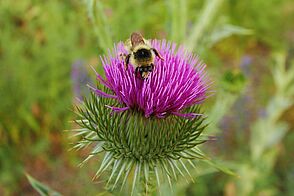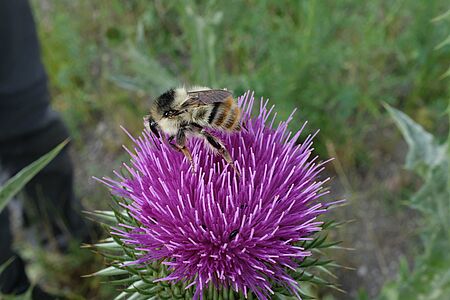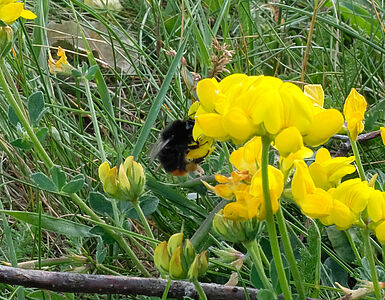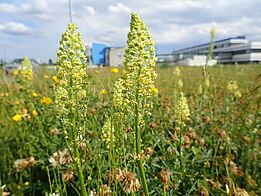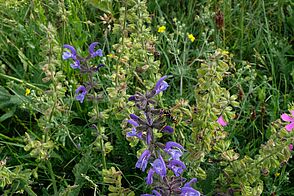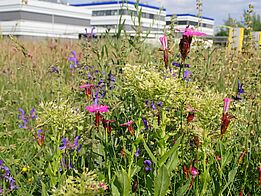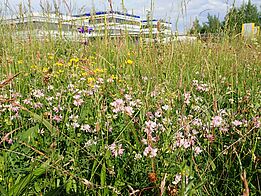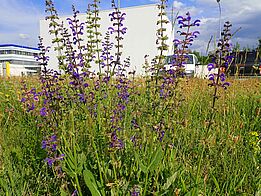Impressive abundance of flowers in late spring—Report of the second inspection of June 1, 2022
Autor*innen: Irene Drozdowski, Jennifer Fischer, Alexander Mrkvicka
Foto-Autor*innen: Irene Drozdowski, Jennifer Fischer, Alexander Mrkvicka
Landschaftspflegeverein Thermenlinie-Wienerwald-Wiener Becken
In contrast to an area that was regularly mowed down from early spring on, the green areas in Seibersdorf showed a diverse flowering splendour and a great variety of insects even in June after the change in maintenance.
In addition to the positive development for biodiversity, the unmown green areas contribute much better to cooling the environment than areas that are mown short. The plants continuously evaporate water, which many species get from the soil with their root systems that reach far down into the ground. The resulting evaporative cold cools the environment.
Despite major drought—the rains in May mostly brought only a small amount of precipitation—many areas bloomed with a great diversity of plant species. This is a special characteristic of dry and semi-dry grasslands. Here, the plants are adapted to little rainfall and can already use small amounts of rain to flower magnificently. In line with the flower diversity, many flower visitors—such as wild bees, butterflies, hoverflies, and beetles—could be observed. Surprisingly, many insects, such as grasshoppers, cicadas, and bugs, which usually need higher meadows like Seibersdorf has but are not adapted to flowers, were present as well.
In particularly dry areas on gravel and sandy soils, dense carpets of Pannonian thyme, tasteless stonecrop, and field stonecrop were just blooming.
In areas with somewhat wetter soils, blooming plants included steppe sage, variegated crown vetch, sainfoin, meadow-flower, arrowcress, yarrow, viper's bugloss, verbena, yellow resede, common bugloss, and Carthusian carnation.
Surprising and special finds were the brown monk’s herb, a rare dry grassland species, as well as the panicle meadow grass, which occurs on the AIT site in a stand of several hundred plants and could only be found again for the second time in eastern Austria after more than 100 years!
Areas where earth has been moved due to construction work are also interesting habitats for many species. These areas develop in many ways if they are not humified and sown with commercially available seeds. In such areas, among others, the special panicle grass as well as many thistles and mullein were found. The latter are expected to produce numerous flowers and insects in the coming weeks.
Nonea pulla—Brown monk’s herb
The brown monk’s herb prefers semi-arid grasslands as its habitat. As a single-flowering species, it usually forms a rosette of leaves in the first year, and the flowers develop in the second year. After the seeds have ripened, the plant almost always dies. New plants germinate from the seeds. If mowing is regularly done early, this species does not flower and disappears after some time. Like all plants of the Ragwort family, it is dependent on cross-pollination—i.e., pollination with pollen from another Ragwort plant—meaning if an occurrence is so small that the plants are too far apart from each other, the species can die out even though it flowers regularly but then does not set any seeds.
Anchusa officinalis—Common bugloss
Common bugloss grows on dry but loamy soils, also on road and vineyard embankments, and along field margins. Like many other broad-leaved plants, it is pollinated by bumblebees for which in turn they are a very important food source. Nowadays, many occurrences fall victim to an exaggerated sense of order because embankments and roadsides are often mulched.
Melica transilvanica—Transylvanian Pearl Grass
The magnificent Transylvanian Pearl Grass is found on very dry embankments, as well as sandy and gravelly areas. It forms large clumps. As with many dry grassland plants, the roots can reach several metres into the ground and thus reach water in deeper soil layers even during superficial drought. When the fruit ripens, shiny silver spikes sway in the wind.
Grasses are an important food source for many insect species. The caterpillar of the checkerboard butterfly, for example, eats grass exclusively. Grass thickets are an important shelter for many animal species. This is where, for example, the variegated bumblebee lays its nest.
Phleum paniculatum—panicle grass
A big surprise during the inspection at the AIT Seibersdorf site is the paniculatum. This type of grass, which is widespread in south-eastern Europe in fields, along roadsides, and on "wasteland", has not been found in eastern Austria for over 100 years. Only two years ago, a few plants were found again in Lower Austria. The find at the AIT site, with several hundred plants on an area which was levelled in autumn, is currently the largest known occurrence in Austria. The seeds remain germinable in the soil for decades and only develop again when they come to the surface under suitable conditions, for example due to construction work or tillage.
Sedum sexangulare—Tasteless stonecrop
With its fleshy leaves, the tasteless stonecrop can store large amounts of water and is thus excellently adapted to dry phases. Even if there is no rain for a long time, it can flower abundantly and is thus an important food plant for many insect species. It can even form large stands in moss cushions on rocks and concrete surfaces where no other plants can grow. Even small fragments of shoots can grow into new plants.
Onopordum acanthium—Cotton thistle
Thistles have adapted to the feeding pressure of grazing animals by forming spiny leaves and stems. As unpopular as they often are with gardeners, with their many flowers and long flowering period, they are incredibly important as food plants for numerous insects active in summer like bumblebees, beetles, and hoverflies to butterflies. The cotton thistle is a single-flowering plant, i.e., it forms a large rosette of leaves in the first year, a large inflorescence the next year, and mostly dies after the seeds have ripened. The seeds only germinate on open ground and are therefore no danger to "golf or garden lawns."
Bombus sylvarum— Shrill carder bee or knapweed carder-bee
The shrill carder bee prefers to live in the lowlands on semi-arid grasslands with wooded areas, in orchards, and along forest edges, but can also be found in the mountains up to an altitude of 1,400 m above sea level. The coloured bumblebee colony consists of 80–150 individuals. Their nesting sites are above-ground and underground mouse nests or other shelters. Above-ground nests are usually built in tufts of grass with nesting material collected by the bumblebee itself.
Bombus lapidaries—Red-tailed bumblebee
The red-tailed bumblebee is not very demanding and lives in meadows, semi-arid grasslands, parks, and gardens. It is particularly fond of horn clover, creeping clover, bird's-foot trefoil, creeping goosegrass, and deadnettle species. They often build their nests under cairns or walls—hence their name (in German: Steinhummel—Stone bumblebee). The red-tailed bumblebee forms small colonies of one queen and up to 300 workers and drones.
Bombus humilis—Brown-banded carder bee
The brown-banded carder bee shows numerous colour variations. It lives in open, flower-rich landscapes such as orchards, semi-arid grasslands, parks, gardens, and roadsides. The queen produces a high-pitched buzzing sound. When collecting nectar and pollen, she does not tolerate other bumblebee species in the vicinity. The nests are above ground, under grass tufts and moss cushions.
Bombus hortorum—Garden bumblebee
The garden bumblebee is one of the more common bumblebee species and can be found throughout Europe up to an altitude of about 2,100 metres. It is a real long-distance flyer, with a flight distance of up to two kilometres. It prefers to nest underground, often in abandoned mouse nests. In rarer cases, it also chooses to nest above ground in abandoned bird nests and bird nest boxes. The young queens often return to their mother's nest site the next year to form a new colony again, consisting of 50 to 120 workers.
Bombus terrestris—Buff-tailed bumblebee or large earth bumblebee
The buff-tailed bumblebee is one of the most conspicuous, largest, and most common bumblebee species: it is a generalist that feels at home in almost all landscapes, including our gardens. It is now used as a very efficient pollinator (the muscle vibration produced by the bumblebee is important) in glasshouses from Iceland to New Zealand for pollination.
With up to 600 bumblebees in a nest, it achieves the largest colony size among the native bumblebee species.













